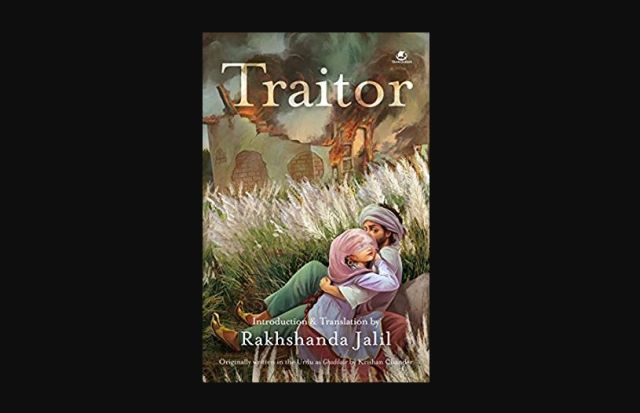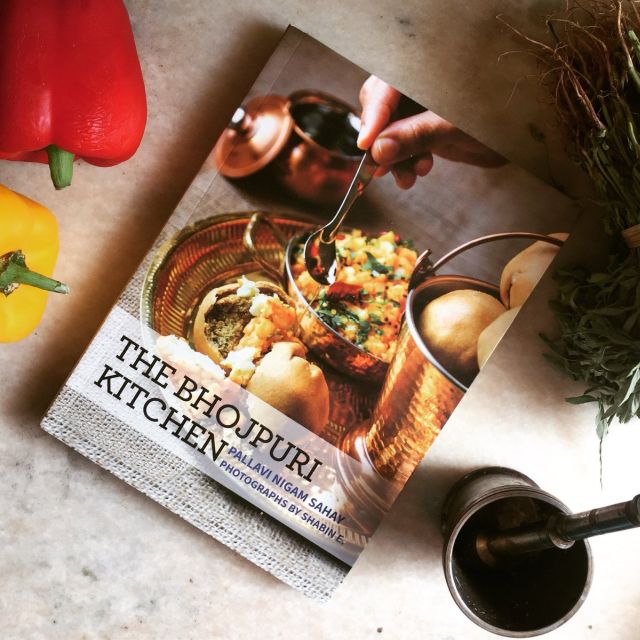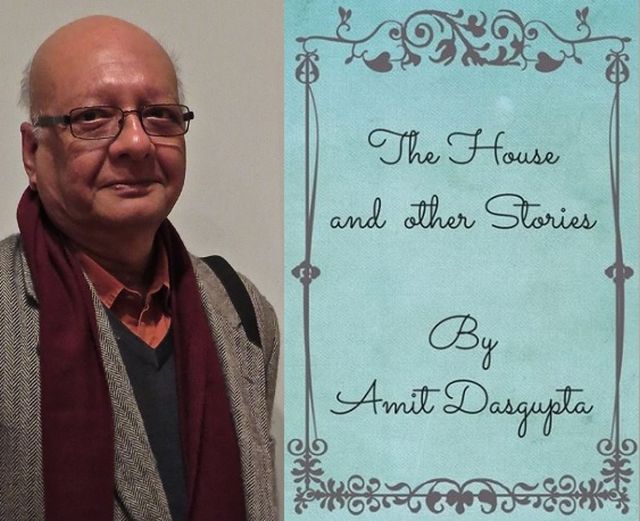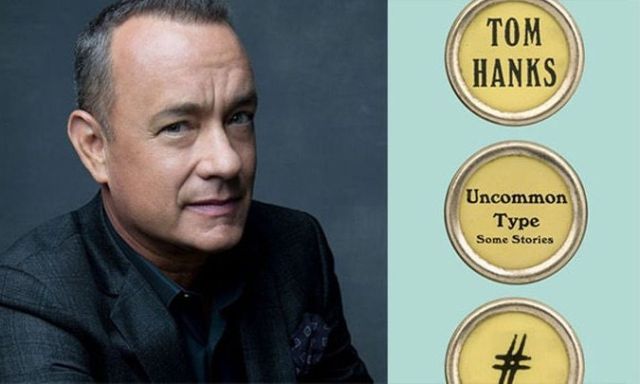
by admin | May 25, 2021 | Books
 By Sheikh Qayoom,
By Sheikh Qayoom,
Book: Traitor (Translation of Krishan Chander’s classic Urdu novel ‘Ghaddaar’) Translator: Rakhshanda Jalil; Publisher: Tranquebar Press by Westland; Pages: 107;
Price: Rs 250 (Also available as an ebook)
Krishan Chander’s ‘Ghaddaar’ is set against the backdrop of the bloodshed that followed the partition of India into two countries in 1947. Reading Rakhshanda Jalil’s ‘Traitor’ makes one realise that the bestial hatred and revenge that set the stage for the massacre of million’s of innocent people in 1947 continues to threaten our claims of a civilised nation. The serpent still lives within the present times and this makes the book an interesting read.
“No monster can be more barbarous than the mob, which assumes the name and mask of the people” — Cicero’s words in ‘Dream of Scipio’ haunted the frenzied rioters of the partition and these rioters in different shades, in the present times, continue to threaten our existence.
Krishan Chander’s protagonist, Bhaijnath, is a married Brahmin in love with Shadaan, an unmarried Muslim girl during a period when the flames of religious conflagration were out to destroy anything even remotely connected with sense and sensibility.
As a ‘Ghaddaar’, the traitor who betrays his race, religion and groups that are out to rape and murder followers of each other’s faith, Bhaijnath stands out as an aberration in the flood of blood and fury that surrounds him.
From Vala village in today’s Pakistan where Bhaijnath’s family of landlords lived comfortably with Muslim peasants who tilled their land, the journey to safety across the newly marked border shatters Bhaijnath’s love and his belief in the goodness of humankind.
Blood-thirsty mobs plunder, rape and murder fellow beings who lived peacefully across faiths till the country’s division was announced, triggering the migration of Hindus and Sikhs to India and Muslims to Pakistan.
Fear of dishonour and death forces fathers to kill children and husbands to stab wives as the younger generations leave behind their old and infirm elders to be butchered by frenzied communal mobs.
Bhaijnath’s journey across the Ravi river into Indian territory takes him to physical safety, but only after he has lost all his values, beliefs and morals. He finds similar mayhem on this side of the border as he fails to understand what actually is his nationality, country and religion.
His son has been murdered by a mob while his wife and other members of the family managed to escape from the newly-created country of Pakistan.
Bhaijnath rushes to save a child clinging to the dead body of his Muslim mother. He sees his lost son in the Muslim child whose fear and consternation are satisfied only after he tells the child ‘I am your chacha’.
Bhaijnath regains his humanhood only after he becomes a ‘Traitor’ for followers of both faiths who are out to exterminate each other.
Written in 1959 and published in 1960, Krishan Chander questions the relevance and warns us against the virulence of jingoistic nationalism and an adrenaline driven idea of a nation.
In Rakhshanda Jalil’s words: “It seems especially brimful with meaning and relevance as we mark the 70th anniversary of the annus horribilis that was the year 1947.”
Bhaijnath prays for a time “when there will be no India even when there is an India. And there would be no Iran, and no Afghanistan, no America, no Russia, no China and no Japan. When the entire earth will be a small village for all its people, where people will live in one place but still love the others and show kindness, freedom and equality while living peacefully and harmoniously”.
The prayer of Krishen Chander’s protagonist has been answered in part. Earth has become a small village, thanks to our technological strides, but the weapons of hate, mistrust, a false sense of superiority driven by a misplaced interpretation of nationalism have become sharper and more lethal.
‘Traitor’ is a must read for everyone who sees the dangers lurking around us as cries of a misplaced sense of nationalism, religion and even secularism become shriller to shake the edifice of our tolerance.
(Sheikh Qayoom can be contacted at sheikh.abdul@ians.in)
—IANS

by admin | May 25, 2021 | Books
 By Saket Suman,
By Saket Suman,
Book: The Bhojpuri Kitchen; Author: Pallavi Nigam Sahay; Publisher: Westland; Price: Rs 499; Pages: 166
Biharis love their food, don’t they? Why else would they carry their “achaar” to far off cities where many of them migrate for work, or queue up in front of the “litti-chokha” stalls outside Metro stations? Now, a trained chef explores the varied cuisine of the state and describes her discovery of the “bhansa ghar” in a new book.
“The Bhojpuri Kitchen”, authored by Pallavi Nigam Sahay, also carries wonderful pictures of the cuisine by photographer Shabin E. Chef Nigam, who trained at the Grand Hyaat, Mumbai, received her culinary diploma from the International School of Italian Cuisine (ICIF).
Strangely, the author did not grow up around the “Bhojpuri Kitchen” and it was only after her marriage that she came to develop an interest in the state’s cuisine. Her curiosity about Bihari cuisine began on her “kacchi” (a ceremony performed a day after the wedding, where traditional dishes are prepared and served to the bridegroom’s party).
“I was absolutely fascinated that day by the delicious baingan badi ki sabji (aubergine curry with black gram cakes), pachphoran kohra (pumpkin cooked with five whole spices), machli ka sarsowala jhol (mustard fish curry), mutton curry, arwa chawal (parboiled rice), spicy chicken kababs and kaala jamun (Cotton cheeses dumplings in sugar syrup). Since then I have been on an unending saga of loving and learning Bihari food. This book is about my beautiful journey across various Bhojpuri bhansa ghars (kitchens),” Sahay writes in the introduction.
She also reminds her readers that almost every festival in Bihar — Holi, Diwali, Dussehra or Chhath — is more about celebrating food and serving different dishes than anything else.
“In fact, Biharis even change their wedding dates to complement their appetites. I have never been to a family wedding on a Tuesday or a Thursday, the two days when the majority abstain from eating non-vegetarian food. No wonder then that one of their ex-CMs was called Rabri, and many kids in the state still respond to a sweet name — Laddoo,” she notes.
So what does a usual day in the Bhojpuri kitchen look like?
Sahay paints a complete picture at the onset of the book. It starts with the aroma of fresh tea simmering on fire. During summer, a refreshing elaichi (cardamom-flavoured tea) is preferred, while on colder mornings a hot, adrak masala chai (spiced ginger tea) is welcome. And this is a very special time as all family members sit together before getting busy with their daily chores.
A traditional lunch comprises steamed rice, daal, bhujia, curd and salad. It used to be the main meal of the day, eaten together by all family members at home. But obviously, owing to altered lifestyles, eating patterns have changed. For evening snacks, there are bachka, bhabhra (Bengal gram pancakes) and choore ka pulao (flaky rice with green peas). They go perfectly with a cup of tea.
Dinner, Sahay mentions, is usually a combination of roti and two types of vegetables. Most families in Bihar, the author maintains, do not opt have rice for dinner, although they may add a non-vegetarian dish such as chicken or mutton to the meal. The menu is a little more elaborate on the weekends.
Sahay also provides elaborate recipes for a wide variety of Bihari dishes — the legendary litti chokha; choora mattar; Bihari halwai-style mutton; machli ka sarsonwala jhor; the delectable bhujias; the unique parwal ki mithai, thekua and other fantastic sweets.
“The Bhojpuri Kitchen” is not only a celebration of several recipes, lest they be forgotten in the future, but also of the region’s festivals like Chhath, which is yet another reason for the kitchens to come alive with food befitting the Gods.
(Saket Suman can be contacted at saket.s@ians.in)
—IANS

by admin | May 25, 2021 | Books
 By Somrita Ghosh,
By Somrita Ghosh,
Title: The House and Other Stories; Author: Amit Dasgupta; Publisher: Yoda Press; Pages: 128; Price: Rs 295
There’s always something appealing about short stories — narrating a tale within restricted pages and yet perfectly delivering thrill or suspense; stories that make the readers finish the book at one go — or, if not, then in the quickest possible time.
Amit Dasgupta’s “The House and Other Stories” succeeds in doing just that. It’s a collection of three stories attached to a single important string called Calcutta (now Kolkata). Not surprisingly, the protagonists are all Bengalis.
Dasgupta, a retired Indian diplomat and now an educator, explains the city thus: Calcutta “as all Bengalis will tell you, even when the city stands quietly in the corner, not saying a word, her presence may be deeply felt by those close to her”, adding that “Calcutta is a city where it is difficult to keep secrets”.
Thus, “Calcutta is the dominant and central character in each of the three stories in this book. Somehow or the other, she keeps coming back again and again”. However, the book is not just about the city, but goes beyond it — and will appeal even to readers who haven’t stayed in Calcutta or are not closely associated with, or accustomed to, Bengali culture.
All this through simple belongings like a diary, a last letter or simply a house that is a witness to many stories and incidents of a family and an individual.
The first story, “Mohua”, might remind the readers of Satyajit Ray’s short stories. The protagonist comes to know about the story of a girl named Mohua Emily Dey, who lived in Dey Mansion on Moira Street with her father, Parimal Albert Dey. Mohua had died some 100 years ago and unnatural happenings are often associated with the house. But the protagonist, under mysterious circumstances, lands up in the house. What happens thereafter is better left for the reader to discover.
“The Little Red Book” is the story of a septuagenarian who is trying to overcome the void created by the death of his wife. Initially, he finds the company of his daughter and her family soothing in Berlin. He decides to return and it is in his home at Dover Lane in Calcutta that he finds peace. He suddenly discovers a horoscope which predicts his death the next year and starts writing a diary for his daughter, but fate had something else in store for him.
The final offering is “The House”, story of an elderly couple, Rajat and Monisha, whose son Aloke flies down from the US after he receives the news of his father not being well. Although Monisha remains hesitant to accompany hers son to the US following her husband’s death, she finally agrees to move to her son’s house — but the house is not a home for Monisha.
The stories succeed in grabbing the attention of the reader. The book’s an absolute page-turner.
(Somrita Ghosh can be contacted at somrita.g@ians.in)
—IANS

by admin | May 25, 2021 | Books
 By Vikas Datta,
By Vikas Datta,
Title: Uncommon Type – Some Stories; Author: Tom Hanks; Publisher: William Heinemann/Penguin Random House UK: Pages: 416; Price: Rs 599
Known for frequently essaying ordinary, likable and good-natured characters facing extraordinary situations in his films, Tom Hanks brings the same aspect to his story-telling. A man is exhausted by his energetic girl friend-turned-girlfriend, the teenager becoming a man on seeing a new side of his father, and a small-time actor discovering stardom’s reality are among the subjects of his examination of the human condition.
Like his films, which range from courtroom dramas to war and espionage thrillers to unconventional romances and more, Hanks covers a wide spectrum in his debut collection of short stories in a host of styles, situations and settings.
While the two-consecutive Oscar-winning actor’s penchant for the telling dialogues or scene or even background is evident, the approach — like his films — is multi-layered, atmospheric and features both alternating regularity and unpredictability as well as complexity of human existence and the tone is usually gentle, conversational and occasionally nostalgic.
There is one pervading motif throughout — typewriters, of which Hanks has a large collection; they figure in all stories, as the book’s name indicates. Yes, it is that type of type.
They are a crucial prop in “These are the Meditations of My Heart” leading the protagonist, recently-separated from the “Knothead”, to find a new perspective to life; a cherished heirloom in recurring ruminations of a newspaper columnist; a useful aid for a father to compose a message from Santa Claus to his children; or even a trivia item found by a man waiting in a car for his girlfriend to finish a business meeting.
Out of the 17 stories, or rather 16 stories and a short play, seven stories are in two arcs.
One is four installments of “Our Town with Hank Fisnet” about the good-natured grumbles of the veteran journalist on various features of modern life, especially modern media — “the only way you’ll be reading my column and everything else you now hold in your hands is on one of your many digital devices — your phone, maybe, or a watch that needs recharging every night”.
The other, which with this collection opens, leaves the bounds of the earth (but returns), and ends in the one featuring an unnamed, laid-back narrator, his on-off-and-on-again girlfriend, the energetic and organised Anna, and his two friends — Steve Wong, and Mohammad Dayax-Abdo, or ‘Mdash’, as he is called by them, who has emigrated from sub-Saharan Africa and has just become a naturalised citizen. And these three stories cover quite a bit of ground between them.
“Three Exhausting Weeks”, introduces them but focuses more on the narrator’s terrifyingly planned and filled time with Anna which “was like training to be a Navy SEAL while working full-time in Amazon fulfillment center in the Okhlahoma Panhandle during tornado season” while “Steve Wong is Perfect” is a stirring evocation of a leisure sports activity becoming a bane if it becomes a command performance.
However, the imaginative and rather surrealistic “Alan Bean Plus Four” — seemingly inspired by Hanks’ “Apollo 13” (1995) — takes the four to new heights as they build a spaceship in the backyard and go around the moon.
Some others do seem inspired by his films too — the graphic bloodiness of combat as seen in “Saving Private Ryan” (1998), crops up in the memories of the discharged soldier in “Christmas Eve 1953”, which otherwise seems an X-Mas story. Then two seem to draw from his own acting experience — from the perspectives of a supporting actor (“A Junket in the City of Light”) and a struggling starlet (“Who’s Who”).
And then, he takes you on a different tack together with the woman who can see glimpses of her future (“A Month of Greene Street”), an unusual take on suburban life (with a Patel family also resident) or time travel (“The Past is Important to Us”).
While comparisons are bound to be drawn with his onscreen persona, Hanks here reveals an unexpected side with the dazzling technique of literary pyrotechnics. With their evocative language and characterisation, they show, in several ways, how human nature can be more strange and unfathomable than what we can think.
This book shouldn’t be missed by fans of either Tom Hanks or good stories.
(Vikas Datta can be contacted at vikas.d@ians.in)
—IANS

by admin | May 25, 2021 | Books
 By Vikas Datta,
By Vikas Datta,
Title: Magnus Chase and the Ship of the Dead; Author: Rick Riordan; Publisher: Puffin/Penguin Random House; Pages: 423; Price: Rs 599
Being with the cosmic forces of good is not always a happy situation for, at some time, you are going to be called in to save the world, while the gods will only render advice — if they feel like it. Though your team has seven other brave warriors, it doesn’t help when one is fasting, two are in a lovers’ spat, and one is gender-fluid/transgender and the rest have their own issues.
And that is when you have cross the treacherous ocean, facing angry sea gods, hostile giants and evil fire-breathing dragons, to thwart the wiles of trickster god Loki and his ship full of zombies and ghosts, whose advent will signal Ragnarok or the final battle. There is also a magical elixir to find en route.
Welcome to the world of Magnus Chase, one of Odin’s “einherji” (chosen immortal warriors) in the third and final installment of Rick Riordan’s “Gods of Asgard” trilogy, as he faces what could be his final adventure.
However with some pluck, some strategic help, fighting and diplomatic skills, he and his friends can work wonders. And in the end, it is the humanness of the protagonists that is key, not any supernatural or paranormal attribute.
The final result may seem evident but its course and the manner of the denouement is what makes this story a frantic page-turner — like all others of Riordan, the “story-teller of the gods”.
But, above all, the author deserves full credit for his unique, contemporary and thrilling take on Norse mythology, which is far from cheery, well reflecting its violent and gloomy setting — ice-bound Scandinavia full of marauding Vikings, its star-crossed heroes and heroines and preordained fall of the gods and the destruction of the worlds (eight others apart from the mortal realm).
Like his popular Percy Jackson series using the old Greek myths, expanded with Roman variants in the “Heroes of Olympus” saga and Ancient Egypt mythology in the “Kane Chronicles”, Riordan imbues the same modern feel, contemporary issues, topped with a tongue-in-cheek tinge, to appeal to a new audience, who may not be aware/interested in the old myths.
First of all, the primary setting for all this is present-day America — Boston in this case, though we cross the ocean to Britain and Norway — and the characters represent a wide spectrum of its diversity and attitudes including a cool acceptance of homosexuality and shifting gender identities.
The Magnus Chase series takes this furthest, with its hijab-wearing, devout Muslim Samirah al-Abbas, who is on Ramadan fasting for the duration of this adventure, Alex Fierro, who switches between male and female genders at will, and mute light elf Hearthstone.
The gods also get a modern makeover — Odin the All-Seeing, the chief of gods, talks like a motivational speaker and we are told that he hung himself for nine days to learn the magic of runes and stood in line in a blizzard for six days to learn the magic of smartphones. Thor, the god of thunder, is more interested in seeing TV shows and uses his hammer more to stream them than to smite giants; and Heimdall, the gatekeeper of the gods’ realm, is now a selfie freak.
Thus it is not only old myths retold, but various less than prepossessing aspects of the human condition and experience woven in, including disability, neglect, parental (or family) abuse and homelessness as well lust for power, greed and mindless violence.
But, there is also friendship, camaraderie and acceptance between a disparate group of people and human resilience, ingenuity and resolve, that can even impress the gods. Also the importance of choice, as opposed to heredity, is still paramount.
For fans of Riordan, this installment also sees a cameo by Percy and Annabeth Chase, who is Magnus’ cousin, and in the end, there is a tantalising glimpse of trouble in the ongoing “Trials of Apollo” series.
And for those impressed with series which began with “The Sword of Summer” (2015) and continued in “The Hammer of Thor” (2016), there are hints that this may not the last appearance of Magnus Chase and his motley crew of dependable friends.
We can only hope.
(Vikas Datta can be contacted at vikas.d@ians.in)
—IANS





